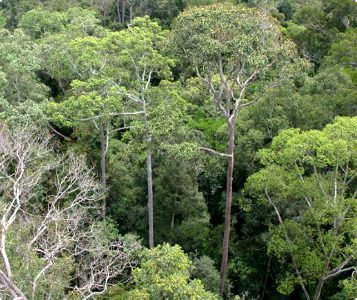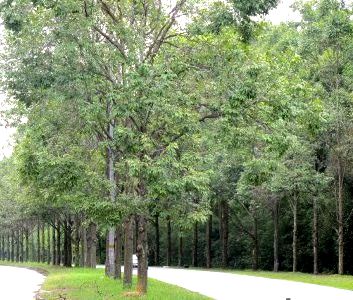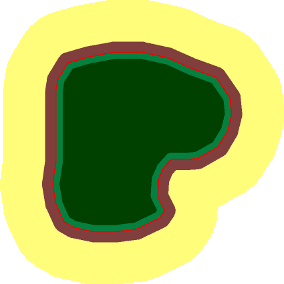Planting local trees for ex-situ conservation and mitigating effects of land uses changes
Large and increasing effects of human actions on the environment led to a situation where non-modified ecosystems are rare. The classic representation of a “natural ecosystems with humans disturbing them” does therefore no longer depict the reality of the terrestrial biosphere that has become dominated by human systems made of more and lesser modified environments. In this context, conservation of the goods and diversity of natural systems in their current state will only last if all environments, including the most modified, are managed in a way that preserves or develops beneficial relations between the more and lesser disturbed ecosystems. Such approach requires small decision-makers, including gardeners to have a visibility of the effects of their individual and collective actions not only on the local environment but also on all interrelated ecosystems. At larger decision levels, trade-offs between 1) satisfying short-term human needs and 2) maintaining other ecosystem functions and goods will require a continuous reassessment of long-term ecosystem responses to land uses and global changes. Trees are structuring elements of many terrestrial ecosystems. Recording and keeping alive their current diversity and services will preserve our capacity of addressing our needs and cultural aspirations in a changing world.


Signification of ex-situ tree mapping
Trees need to be understood as parts of breeding populations that have evolved in interaction with their environment. In this context, “in-situ” qualifies the presence of a given tree within a population and a habitat that contributed to the history of its evolution. In opposite, “ex-situ” refers to a habitat in which a given tree or tree population would not naturally establish or become invasive if introduced. The objective of ex-situ tree mapping is to build knowledge able to support action for keeping environmental disturbances as low as possible by the maintenance of native tree species in areas that were not primarily intended for conservation such as urban, agricultural and industrial landscapes.
Importance of diversity for species conservation
A species is a unit of biological classification referring to a group of organisms able of interbreeding and producing fertile offspring. Such group becomes threatened when habitats in which it has evolved are lost or when environmental changes induced by the introduction of new competitors, diseases outbreaks, climate change, etc, overcome its capacity of adaptation. Species capacity to adjust environmental modifications varies with its level of genetic diversity. If this diversity is reduced through inbreeding in fragmented populations or genetic pollution trough the influence of selected and cloned material that fertilize smaller natural populations, the species may loose its capacity to withstand even natural environmental variations that contributed to its own evolution.
Preservation of natural habitats
Protected forests and developed areas inevitably interact and the intensity of induced perturbations in protected areas depends directly to its area-perimeter ratio as well as to the harshness of the surrounding environment. In these conditions, ex-situ plantations at the forest edge are able to buffer the influence of adjacent environment on the protected area (Figure 4). This protection increases if the structure and species composition of the buffer zone gets closer to those of the conservation forest. By the same mechanism, ex-situ plantation can restore biological corridors between scattered forest reserves increasing their capacity of habitat conservation.
When local species are planted in a buffer zone, special consideration should be given to the choice of provenance. Fertilizations of trees in the conservation area by provenance that are not suited to the local environment will decrease the ability of the offspring to survive. On the other hand, plantations grown from seeds collected in similar environmental situation will reduce the risks of inbreeding depression within the conservation area.
Figure 4. Expected effects of a buffer zone on a forest reserve.A: without buffer zone B: with buffer zone. The buffer zone protects the forest from disturbances. Expected effects are an increased proportion of intact conservation forest and a larger zone of forest influence on the surrounding area.
Local tree diversity, cultural identities and economical perspectives
If “in-situ” conservation is essential, maintaining local trees only in restricted and uninhabited areas would deprive most citizens from their benefits. Local trees and associated fauna and flora are sources of food diversity, natural remedies and historical meaning. Favoring local trees in living environments will root actions of eco-responsible development in a base of regional traditions and societal histories. If appropriate seed supply is limited in a context of mass marketing and mass consumption, the (re-)integration of native trees in landscaping will favor the development of niche markets and professional expertise, helping the restructuration and revitalization of local economies. In such context, specialized nurseries working in close relation with regional environmental players could take benefit from collaborative web mapping and publishing services (Figure 5) in order to reach the largest number of decision makers and collaborators for the implementation of an integrated ex-situ biodiversity conservation plan.
SALES VOLUME
Current offer, mainly high sales volumes of clonal cultivated varieties
The "long tail" offer to be developped and corresponding to local trees with high inter- and intra-specific diversity. Nurseries specialized in niche market are made visible on internet.
DIVERSITY

Figure 5. Prospects of “long-tailed market” for the preservation of environmental diversity
Supplying trees for environmental conservation requires a large choice of local tree provenances with low sales volumes (the green tail on the figure).
The development of this market can be achieved via the internet where inventory, search and filtering technologies are connecting supply and demand.


